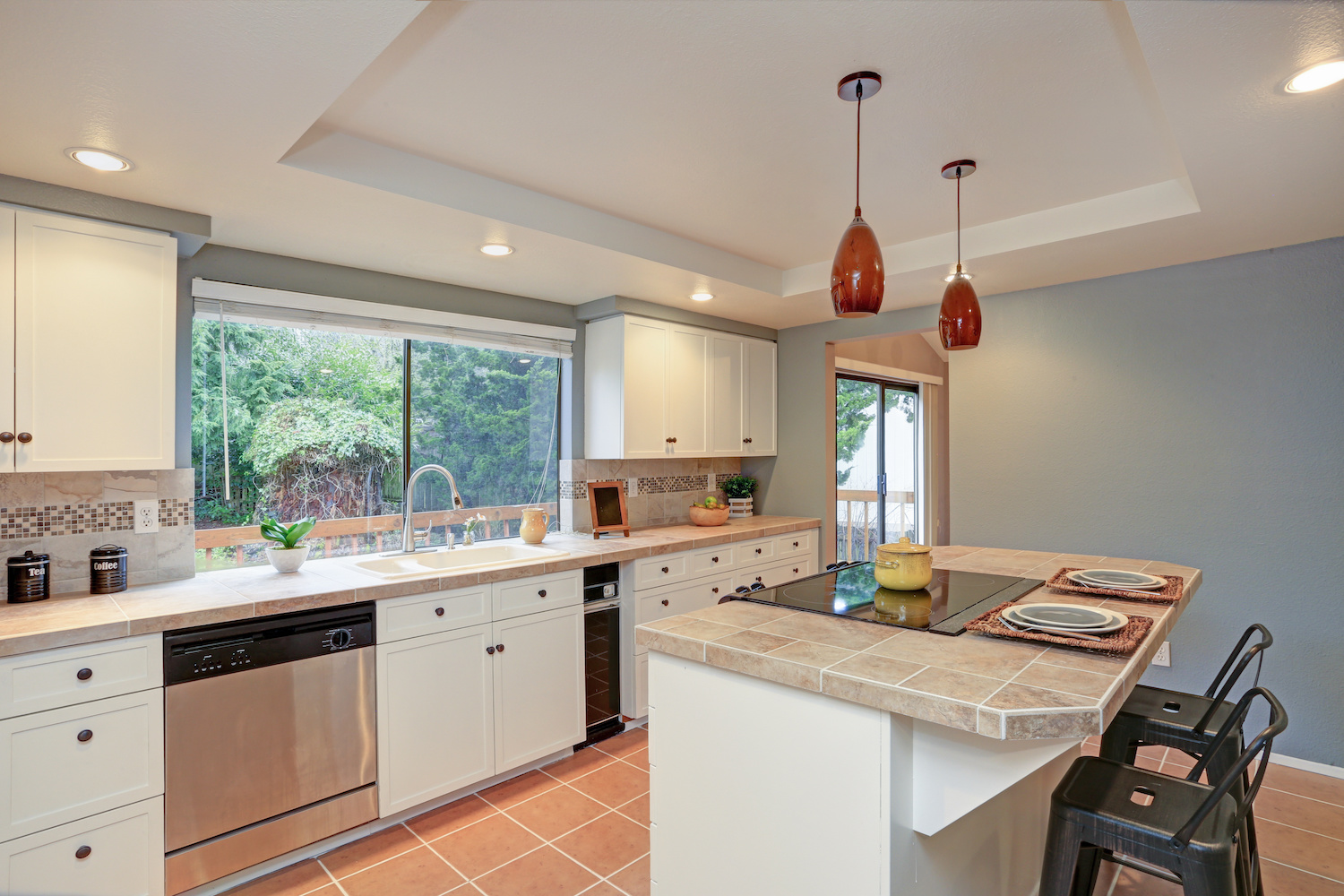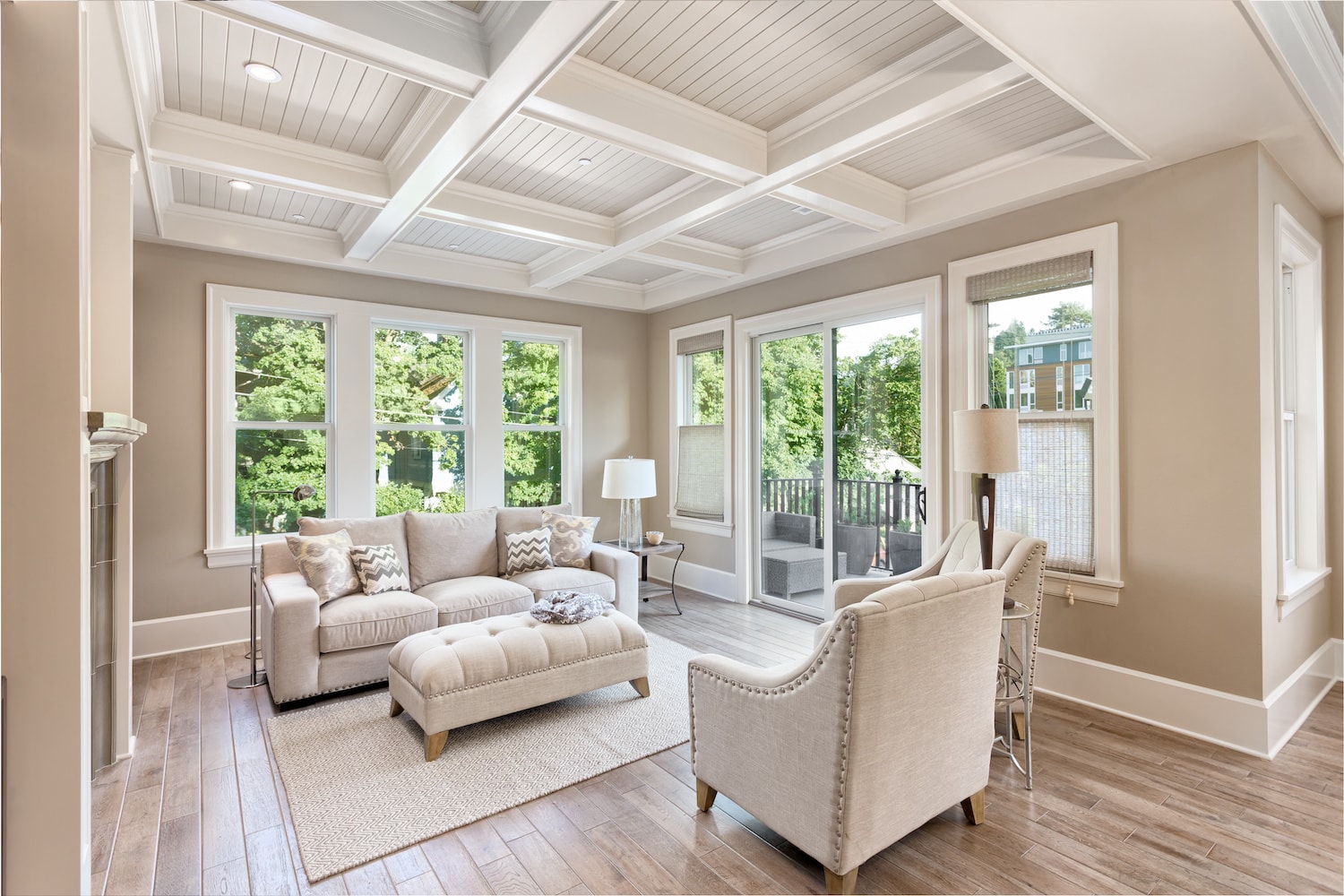Have you ever looked at your home and felt that something was missing? Maybe the room is just feeling a little “blah,” or the space is missing that special ambiance you want to create. You’ve painted the walls and rearranged the furniture, but still. Something is not quite right.
It’s probably never occurred to you that the culprit could actually be your ceiling!
Despite the fact that ceilings take up as much space as the floor, they remain the most overlooked surface when it comes to interior design. The truth is a ceiling can hugely influence the overall feel of your home. A stylized ceiling can add
- A focal point
- Visual appeal
- Make a small room feel larger
Two of the most popular decorative ceiling styles include coffered ceilings and tray ceilings. While the two share some similarities, they create two distinctive moods. So, how do you choose which is right for you?
Read on to learn about the pros and cons of a coffered vs. tray ceiling!
What Is a Coffered Ceiling? 🤷♀️
A coffered ceiling is one of the oldest decorative ceiling styles in use today. Originally popularized during the renaissance period, coffered ceilings add classic detailing to any home.
“Coffer” is a term that means indentation. A coffered ceiling features a series of indentations on the ceiling, typically in a square or rectangular pattern. This creates a sort of raised, checkerboard-like shape on your ceiling.
Coffered ceilings are perfect for homes that are looking to add architectural details that add character and history to their existing ceiling.
What Is a Tray Ceiling? 🤷♂️
Like a coffered ceiling, a tray ceiling also relies on an indentation to create visual interest. Tray Ceilings have only one indentation, though. The center section is raised, and a border is added, creating the look of an upside-down tray on your ceiling.
Tray ceilings can be built in a variety of different shapes to suit your design scheme. As such, modern homes typically opt for a tray ceiling vs. a coffered ceiling, as it can be built to match more current design sensibilities.
How Much Do They Cost?
The cost of your new ceiling will vary greatly depending on the size of your room and the style you choose. In general, you can expect to pay around $1000-$1500 for a standard tray ceiling. Coffered ceilings tend to be more expensive, with average costs coming to roughly $25 per square foot.
Pros and Cons of a Coffered Ceiling
Want to learn more about a coffered ceiling? Here are some pros and cons to keep in mind.
Pros 👍
- Adds Historic Detailing – Because coffered ceilings have such a long history, they instantly evoke the sense that your home is from another time period. If you are restoring a historic home – or looking to add character to a new build – a coffered ceiling is a great choice.
- Creates Visual Interest – The crossed beam pattern of coffered ceilings instantly adds visual interest to a room. If you like to keep your color scheme and furniture simple but don’t want the room to feel unwelcoming, a ceiling treatment such as a coffered ceiling can help!
- Creates a High Ceiling Effect – Because the design draws the eye upward, it can help make a small room feel taller than it is.
- Helps Eliminate Echoes – Coffered ceilings absorb sound, making them an excellent choice for spacious, echoey rooms.
Cons 👎
- Cost – They say beauty comes with a price, and that is especially true when it comes to coffered ceilings. With the average living room being about 350 square feet, you can expect to pay around $8,700 for your coffered ceiling.
- Cannot Be Installed In Every Home – Coffered ceilings are not an appropriate design choice for every home. Because they take up a significant amount of overhead space, they require a room with a high ceiling.
- May Reduce Headroom – Coffered ceilings inevitably reduce headroom. If you are concerned about your ceiling height, this is definitely something to take into consideration.
- Requires Advanced Carpentry Skills – Unfortunately, a coffered ceiling does not make for a good DIY project. The installation typically requires professional installation.
Pros and Cons of a Tray Ceiling

Drawn to the versatility of a tray ceiling? Here are some factors to consider.
Pros 👍
- Can Increase Resale Value – A tray ceiling adds a level of beauty and detail to your home that can increase resale value in the future.
- Draws The Eye Upwards – Tray ceilings are a neat little trick for anyone who wants to make their ceiling feel taller than it is.
- Can Make A Small Room Feel Larger – The raised ceiling can make a smaller room feel like a much larger space.
Cons 👎
- Can Reduce Headroom – Tray ceilings require a drop-down border to be installed. This can ultimately result in reduced headroom.
- Difficult Maintenance – Depending on the style you choose, tray ceilings can be tricky to maintain. Paint touch-ups may be needed, as well as dusting and cleaning.
Which Style Is Best For Me? 🛠️
When it comes to choosing whether coffered and tray ceilings are right for you, it’s important to consider all of the above factors.
In general, we recommend a coffered style for homes with higher ceilings and a more classic, traditional style. Coffered ceilings look beautiful in large living rooms and dining rooms.
Tray ceilings are much more versatile and can be designed to go with any type of design scheme. They work well in living rooms, bedrooms, and even kitchens! If you want one in your kitchen, however, keep in mind that it may affect the height of your upper cabinets.
Contact a Professional Remodeler ☎️
Ready to create a beautiful ceiling that with a huge impact? At Thomas Buckborough & Associates, we have over thirty years of experience in the design and renovation industry. Our award-winning team will assist you through every step of the process. Contact us today to set up your virtual consultation!



